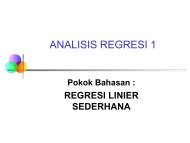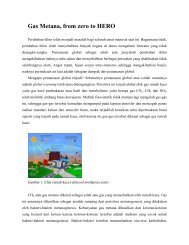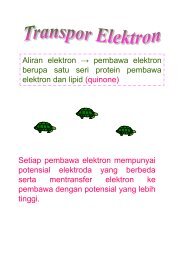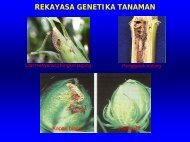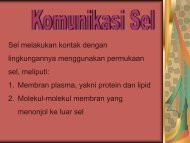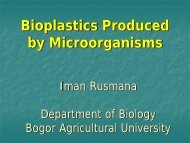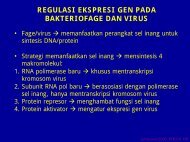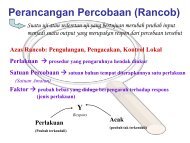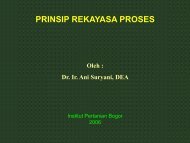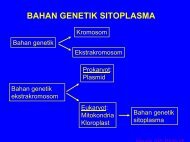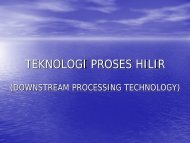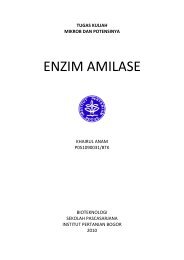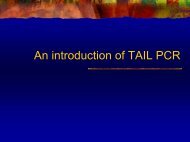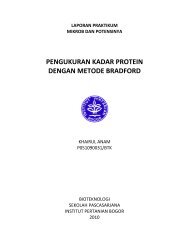Microbial Bioinsecticide
Bacillus thuringiensis Bacillus thuringiensis
Bacillus thuringiensis Bacillus thuringiensis
- No tags were found...
You also want an ePaper? Increase the reach of your titles
YUMPU automatically turns print PDFs into web optimized ePapers that Google loves.
<strong>Microbial</strong> <strong>Bioinsecticide</strong><br />
Bacillus thuringiensis<br />
Aris Tri Wahyudi, PhD<br />
Department of Biology<br />
Bogor Agricultural University<br />
2010
<strong>Microbial</strong> Insecticide<br />
• A microbial bioinsecticide is an organism that<br />
either produces a toxic substances that kills an<br />
insect species or has the capability of fatally<br />
infecting a specific target insect<br />
• The most studied, most efective, and most often<br />
utilized are the toxins synthesized by Bacillus<br />
thuringiensis (Bt).<br />
• Bt comprises a number of different strains<br />
(subspecies; subsp), each of which produces<br />
different toxin that can kill certain specific insect
Insecticide
Bt Toxin<br />
, 95 %Protein, 5% CH
Mode of Action<br />
• The parasporal crystal is not the active form of the insecticide,<br />
rather, it is a protoxin, a precursor of the active toxin.<br />
• When the parasporal crystal is ingested by a target insect, the<br />
protoxin is activated within its gut by the combination of alkaline<br />
pH (7.5-8.0->>) and specific digestive proteases, which converts<br />
the protoxin into an active toxin (Mol Mass ~68 kDa.)<br />
• In its active form, the toxic protein inserts itself into the<br />
membrane of the gut epithelial cells of the insect and create an<br />
ion channel through which there is believed to be an exessive<br />
loss of cellular ATP.<br />
• Cellular metabolism ceases, the insect stops feeding, becomes<br />
dehydrated, and eventually dies. Because conversion of protoxin<br />
to active toxin requires : alkaline pH and specific proteases.
Specific Activation of Bt
Mode of Action<br />
Outside cell<br />
Inside cell<br />
Efflux of ATP<br />
Toxin protein<br />
Ion channel<br />
Gut epithelial<br />
Cell membrane<br />
Insertion of the B. thuringiensis toxin into the membrane of an insect<br />
Gut epithelial cell. Toxin forms an ion channel between the cell cytoplasm<br />
and the external environment
Toxin genes are located on plasmid<br />
or chromosomal DNA?<br />
• Total cellular DNA is isolated and separated into<br />
plasmid and chromosomal DNA by CsCl2<br />
gradient centrifugation.<br />
• Protoxin gene part of genome, clone bank is<br />
contructed from chromosomal DNA.<br />
• Protoxin gene is a plasmid encoded, plasmid<br />
DNA can be further fractionated by sucrose<br />
gradient centrifugation….separate different<br />
plasmid according to their size.
B. thuringiensis subsp kurstakii<br />
• Protoxin gene on one of 7 different plasmid: 2.0,<br />
7.4, 7.8, 8.2, 14.4, 45, and 71 kb. Which plasmid<br />
carries protoxin gene?......... By Succrose Grdient<br />
• Three fractions: small (2 kb); medium (7.4, 7.8,<br />
8.2, 14.4 kb); large (45, and 71 kb).<br />
• Medium and large are partially digested with<br />
Sau3AI and ligated into BamHI site of plasmid<br />
pBR322.<br />
• Transformation to E. coli, and screening by:
Screening colonies carrying<br />
protoxin gene<br />
• Colonies are transferred from agar plate to<br />
nitrocellulose membrane.<br />
• The transferred colonies are lysed: NaOH<br />
• Protoxin gene 71 kb plasmid used as a probe<br />
labelled with digoxigenin (Non-radioactive)to<br />
hybridize with plasmid (hybridization)<br />
• Visualization by X-ray film
Genetic Engineering of Bt<br />
• Expression of toxin gene is occurred only during<br />
sporulation<br />
• DNA fragment containing a toxin gene that lack its<br />
native promoter cloned into a plasmid under the<br />
control of continuously active, constitutive promoter<br />
from Tc resistant gene that had been originally isolated<br />
from B. cereus plasmid and reintroduced to Bt-----<br />
Active toxin protein was produced continuously<br />
throughout the growth cycle: vegetative and sporulating<br />
phases.
Tn5
Bt Toxin Engineering
Bt Toxin in Water and Underfoot
Scorpio-Toxin Baculovirus



